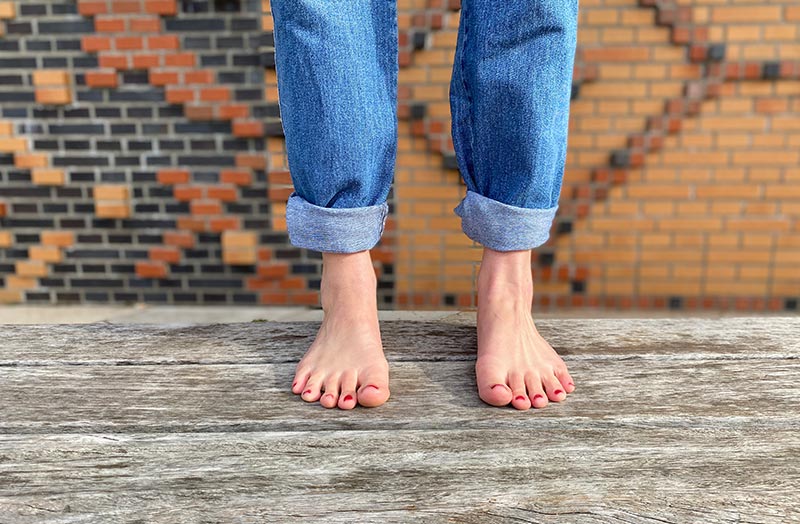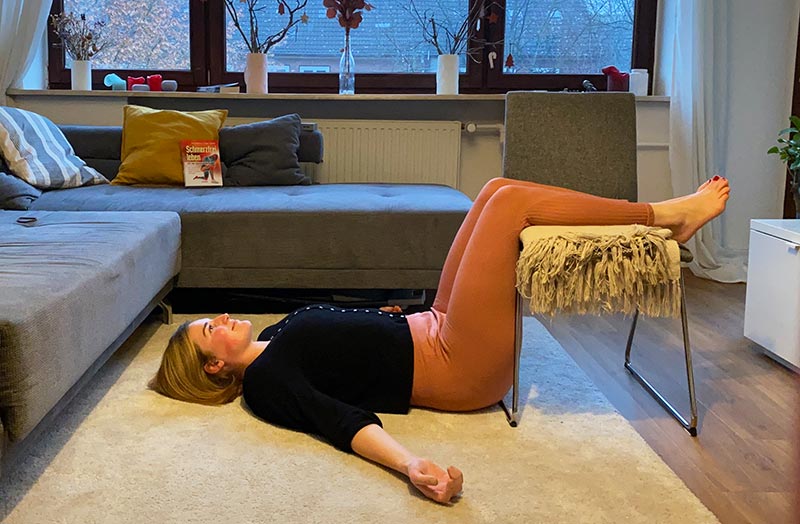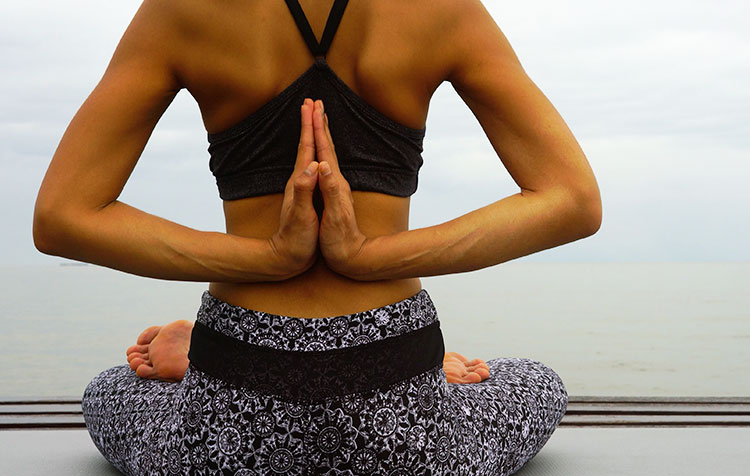You want to improve your posture? Then you've come to the right place! "Sit up straight!", "Cheer up!", "Don't hang your head." - We've all heard those sayings, right? These types of sayings may also be the ones that have significantly shaped our definition of posture. When we think we need to maintain an upright posture, we usually pull our shoulders back first. Some people have also heard that tightening the abdomen and buttocks helps to improve posture. But in the long run this has hardly any effect.
In this article I would like to give you the necessary knowledge and the best tips for a short and long term optimal posture.
3 tips for a fundamentally better posture in advance
I know you want to improve your posture! But before I get to the 10 tips I promised, here are some basics for ideal posture.
1. what actually defines posture?
Posture is ultimately the position of your bones in relation to each other, which is influenced by muscle strength. It is significantly influenced by our everyday life and therefore the posture is also different from person to person.
"Bones do what muscles tell them to do."
This quote from Pete Egoscue (founder of the Egoscue Method) deals with just that. Depending on how the muscles are used or not used, the bones move and the joints change.
2. what influence do incorrect postures really have?
Misalignment of certain bones or joints does not happen out of nowhere. As already mentioned in the first part by the quote from Pete Egoscue: muscles are responsible for the movement of bones, not the other way around. So, for example, if the position of the hip changes permanently, so that it is elevated on one side when sitting, standing and walking, for example, this also inevitably means that the muscle work has changed and imbalances have arisen.
Changes in muscle function consequently lead to compensation by other muscles. An example of this is external rotation of the thigh bones, which often happens when the hip flexor muscles shorten, causing the hip to tilt forward.
Noticeable consequences due to incorrect posture can become apparent very quickly, for example through painful tension or chronic pain. Necrosis, arthrosis, stress fractures, herniated discs and much more can also be the result of years of misalignment and thus incorrect stress.
3. how can I improve my posture myself?
Already build stretching or mobility exercises into your daily routine on a regular basis, and you'll be able to check for muscular restrictions yourself.
The calf is a good example to explain it:
- 1st option: Your calves are very hardened and only a small stretching stimulus already causes a strong stretching pain. At this point it is recommended to continue this stretch gently and especially regularly.
- 2nd option: Even with the balls of your feet on a stair step and intense "downward pressing" of the heel, there is little stretching pain in your calf. This shows that the muscle stretching function in the calf is working well. Instead, it would be recommended to perform a light activation of the muscles, for example by regular up and down movements on the toes.
This way you can check the functionality of many muscle groups yourself.
Improve posture - 10 tips for the ideal posture in everyday life
The good news is that the 10 tips do not include "Always pull your shoulders back! Instead, in the following tips you'll find advice and exercises that are easy to integrate into everyday life and will improve your posture in the long term. Let's go!
1. correct your foot position
If you look at the position of other people's feet at the train or bus stop today, you often see that the heels point inwards and toes outwards. The fact that this is a very common deformity is also widely believed to be the straight and neutral foot position.
Instead, however, it looks like this:

In sitting as well as in standing position, if your gaze falls to the floor and to your feet, the foot position can be easily corrected to the position you see in the illustration.
2. pay attention to your weight balance
Test the following: stand and position your feet straight and parallel as shown in the picture in point 1. Concentrate on the weight distribution and answer the following questions:
- Is there more weight on the right or left foot, or is the weight balanced?
- And is more weight on the heel or the ball of the foot? Is this weight distribution the same on the left and right foot?
- Do you feel more weight on the inside edge or outside edge, or is the weight centrally distributed?
Make an effort to distribute your weight evenly, as if you have a central point in the middle of your foot where you want to put all your weight. Every time you stand, you can do this weight balancing.
3. keep the hands free for the natural arm swing
We often have a cell phone or purse in our hand or are holding another person's hand. We may also have our hands in pants or jacket pockets or holding onto the strap of our backpack.
In running, we have a natural arm swing that we block through all of this.
So make an effort, if possible, to Walks oder jeglichen Fußwegen deine Hände freizuhalten. So kannst du deine Körperhaltung verbessern – fast im Vorbeilaufen. 🙂
4. walk barefoot or in socks

When it comes to the subject of shoes, the topic of "the right sole" is much discussed. However, the narrowness or width of the shoe is often neglected. While a normal shoe may not noticeably squeeze a foot, it does bring the toes much closer together than they naturally should be, significantly restricting the muscle activity of a variety of muscles in the foot. As a result, they unlearn how to work properly.
Therefore, if possible, refrain from wearing footwear or find out about footwear that still allows the foot to work on its own, such as Barefoot shoes. At this point, however, caution is advised: after years of muscular restrictions due to shoes, the foot muscles are weakened. From one day to the next to barefoot shoes or Barefoot running So to change is a very intense demand on muscles that no longer know how to function properly. So proceed with care and caution.
5. reorganize your desk
Do you sit at your desk a lot? Then you've probably had the same order on your storage surface for months and years. The phone on the left, the water glass on the right, the filing cabinet on the right and the handbag or backpack on the left on the floor. This leads to the at the beginning mentioned daily repeated and subconscious movement patterns. So rearrange your desk occasionally to break up these movement patterns.
6. also breathe into the side
The topic of breathing is complex and actually deserves a whole separate blog post. I'll try to keep it short: for optimal use of the entire diaphragm, it's already a good step to breathe forward into the abdomen, "breathing into a balloon," so to speak. However, a balloon also inflates to the sides.
Use the following exercise if you want to improve your posture. Place your hands on the sides of your waist so that your thumbs point backward and the rest of your fingers point forward. Make an effort to inhale not only to the front, but also to the sides. The inflation will not be as noticeable in the sides as in the front, of course, but it will be more noticeable in the back. you use your entire diaphragm in this way and not just parts of it.
7. have a cushion or yoga block at hand at the desk chair
We are a sedentary society. Not only people who work at a desk sit a lot. Active people are also in the same boat - and sit in the car, on the bus, on the train, at breakfast, lunch and dinner. Sitting per se is first of all nothing bad for the body. However, by doing it so often and for so long, our bodies adapt to it and often forget to return to neutral joint positions even after getting up. This leads to muscular imbalances.
Sitting is a voluntary activity, out of the neutral position. For this Active hip flexion required. However, after hours of sitting, the hip is anything but active, but instead the muscles are simply shortened.
Take a Yoga block or a pillow at hand or roll up a large towel and place it between your knees while sitting. Then actively roll your hips forward, aiming to actively shorten your hip flexor muscles. Squeeze the pillow about 60 times with about 50-60 percent of your strength, keeping your hips rolled forward throughout. Relax your shoulders by letting your arms hang by your sides. By doing this, you'll teach your hips that hip flexion is an active movement, not the neutral position!
8. do rotating exercises
The range of motion of the spine is nothing like that of our shoulder joint, for example. However, the spine can not only bend and stretch, but also rotate around its own axis. Rotating movements, however, are found only rarely in our everyday life.
Therefore, every now and then build in an exercise that rotates the spine. Note, however, that the hip remains stable and does not rotate with it - otherwise it is not the muscles of the spine that perform the rotation, but the muscles of the hip.
9. use the relaxation exercise "Static Back

Static Back is an exercise that is not only often used in the Egoscue Method, because it brings two decisive advantages:
- Does it often leads to rapid pain relief from back pain and provides
- For a reduction of rotation in the upper body and pelvis, as well as forward or backward tilting of the pelvis.
Rounded shoulders and the spine also have the opportunity to slide back into a more natural position due to gravity.
Stay in the position for at least 5 minutes or longer and keep your arms relaxed. So it is not advisable to read a book or answer the messages on your cell phone in this position.
If your shoulders are very rounded, you may notice that your cervical spine is hyperextended in the supine position. You'll notice this because your gaze will go behind you to the ceiling in this position, rather than directly above you. In this case: take a thin pillow and place it under your head.
10. move!
Exercise does not necessarily mean sweaty sports. Instead, movement in the context of posture means the use of all functions of the musculature. Rotation, extension, flexion, muscle stretching and shortening, pulling movements and pushing movements.
Whether this is through dancing, strength training, climbing or swimming is up to you. First of all, no form of exercise is better than the other. It should only be ensured that all functions of your muscles are used regularly for the purpose of their maintenance.
That's a good thing! You need to move more? Then also take a look at why you should basically more time outside in nature should spend.
Use the tips for better posture
Now you have the necessary expertise and 10 tips for ideal posture at hand. I hope that I could help you to a better posture today. Do you have any questions or suggestions about the tips in this post? Then feel free to write me a comment.
Stay healthy,

PS: Feel free to look further in the natural health blog around. There you will learn, for example, why all people stop smoking immediately should.






